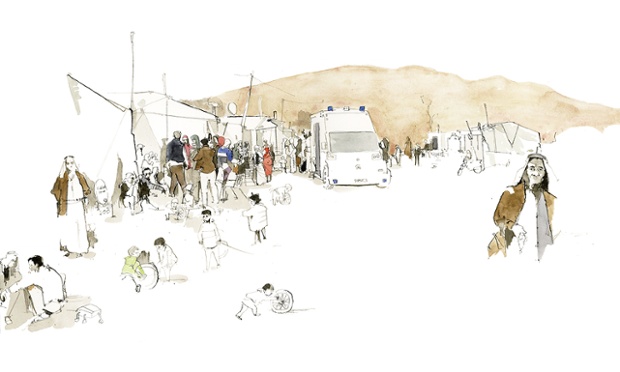The Guardian – ‘We left when the bullets were falling like rain’ – Syrian refugees’ illustrated stories

Article written by George Butler, a reportage illustrator, who tours around the world and paints evocative life stories. This article was published in the Guardian on the 27th of May,2014.
Earlier this year, artist George Butler spent several days in the refugees’ ‘tented settlements’ of northern Lebanon. His portraits of the people – and the often random possessions they brought with them when they fled their homes – tell their own poignant tales. Picture captions by Nick Rice
In March, I spent eight days drawing in the refugee camps or “tented settlements” as they are now called in the Bekaa valley in northern Lebanon. These settlements, medical clinics and schools are supported by Doctors of the World UK, who provide primary healthcare to tens of thousands of Syrian refugees across the country.
Having drawn in Syria several times over the last 18 months and having started a small charity delivering humanitarian aid across the border into Syria, I was aware of the conditions.
However this was very different from my last trip. There were no immediate signs of war, no tanks, no field hospitals, no walking wounded, no men in black headbands with Kalashnikovs. And yet with a million refugees now in Lebanon this was likely the most common experience of innocent people caught up in the war. Families of between eight and 12 people living in wooden-framed tents; tents in groups of five, 10, 15 and 65 on the sides of roads, in fields and next to vineyards. Often these tents were wrapped with discarded and unintentionally ironic advertising panels to keep the sun off and rain out. One featuring a Real Madrid footballer, one with female models on a catwalk and another even pictured a block of smart flats, presumably for rent, somewhere desirable – now the images were stretched around the last place on earth you would ever wish to live.
The drawings describe my seven days in the tented settlements in El-Qaa, Al-Ain and Kamed el-Loz. They show some of the people we met and the places they now live in. After listing the obvious practical things they needed for survival (water, food, medicine) going home was their biggest desire.
With passports and identification fast expiring, many of the Syrian refugees feel more trapped in Lebanon than they did under the bombs of the Syrian regime or the erratic nature of the opposition. They have few rights, no work – just the memories of a civilised, educated, clean, healthy life only three years earlier. Some told us they had been crossed off the UN refugee register, their only lifeline, unable to reapply.
It took me several days to work out how to describe these stories. Eventually, I asked some of the families if I could draw the possessions they had brought with them from Syria. I expected, of course, that these would be precious objects with sentimental value or gifts from loved ones. I was soon put straight.
In reality, these were the things they grabbed when the shelling started or when the lights went out; they were the objects left whole in the rubble of their homes, the things the kids happened to be holding or the stuff left in the car. More often than not they had no possessions at all.
It was now junk, with no useful purpose – but junk that connected them, although indirectly, to their previous life. Junk they could not throw away. The remote control for the TV, the clock, a broken lighter, an old keyring, keys for a motorbike stolen in Syria, a friend’s telephone number, a photo of a seven-year-old son left behind so he could go to school. This was the reality of it.
• These works will be shown at a private view on the 20th June in the V&A museum hosted by Doctors of the World. Doctors of the World UK provides healthcare to vulnerable people, wherever we’re needed most – in this case for the million Syrian Refugees in Lebanon.
Original article on theguardian.com available here
More information about our programmes in Lebanon